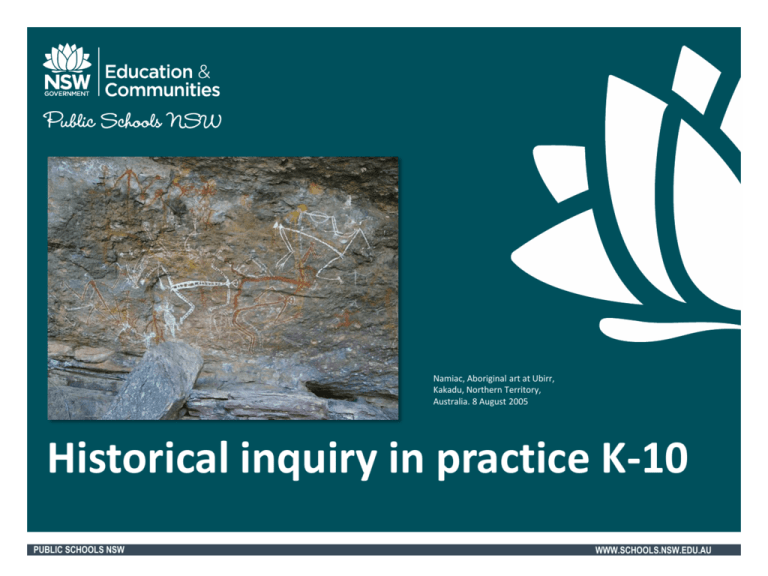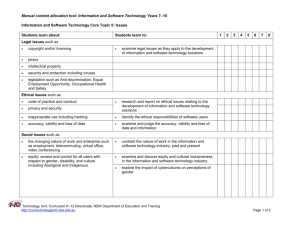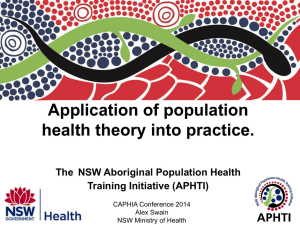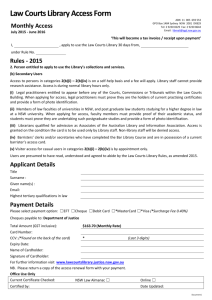Historical Inquiry PowerPoint
advertisement

Namiac, Aboriginal art at Ubirr, Kakadu, Northern Territory, Australia. 8 August 2005 Historical inquiry in practice K-10 PUBLIC SCHOOLS NSW WWW.SCHOOLS.NSW.EDU.AU Historical inquiry Stage 4: Depth Study 1: Investigating the Ancient Past The first topic in Year 7 has been chosen to explore how primary and secondary teachers use the historical inquiry process in context. PUBLIC SCHOOLS NSW WWW.SCHOOLS.NSW.EDU.AU Process: observing, questioning and planning Step 1 – Plan the topic Key inquiry question: How do archaeologists and historians know about the ancient past? (p.41 of printed syllabus) The first thing we need to do is to ask three fundamental questions: 1. WHY teach this topic? How to put into practice the skills of inquiry used by historians? 2. HOW to teach the concept in WHY? Use the ancient past of Australia to determine how sources are analysed and conclusions drawn. 3. WHAT is the actual content needed to convey the concept of the difference and similarities between historians and archaeologists? PUBLIC SCHOOLS NSW Learning across the curriculum: Aboriginal and Torres Strait Islander histories and cultures Sustainability Critical and creative thinking WWW.SCHOOLS.NSW.EDU.AU Process: Research Step 2: Contextualise the topic Teachers research and contextualise the topic for their students. What can students learn about the ancient past by looking at ancient Australian sources? What does this tell them about the way resources were used? Aboriginal Rock Art, Anbangbang Rock Shelter, Kakadu National Park, Australia PUBLIC SCHOOLS NSW WWW.SCHOOLS.NSW.EDU.AU Process: Interpreting and analysing Step 3: Locate sources relevant to the topic Interpret, analyse and form opinions through locating sources that are relevant to the topic. Students analyse the sources, through observation, discussion and creatively thinking about the artefacts using examples such as: • Lake Mungo – human remains • Animal remains • Tools • Art • Dreamtime stories • Middens dfinnecy from Homeless via Sydney http://www.flickr.com/photos/11567325@N00/53626345 PUBLIC SCHOOLS NSW Aboriginal painting in Grampians National park in Victoria, Australia WWW.SCHOOLS.NSW.EDU.AU Process: Interpreting and analysing Step 4: Analyse the sources Students analyse the sources by questioning each source: • What type of source is it? • Why was the source made? • Who was it made for? • What information can we get from the sources? What is it made of? • What is fact and what is opinion when looking at sources? • How might other people interpret the source? Outcome HT 4-5 identifies the meaning, purpose and context of historical sources Historical concepts and skills – perspectives, significance, analysis and use of sources Bungaree, Australian Aboriginal leader PUBLIC SCHOOLS NSW WWW.SCHOOLS.NSW.EDU.AU Process: Concluding and communicating Step 5: Develop a response to the key inquiry question Students communicate their learning and develop a response to the key inquiry question. Students communicate verbally or physically what the sources reveal of Australia’s ancient past, such as label text to accompany a museum display. Historical skills and concepts – perspectives, significance, analysis and use of sources, contestability, explanation and communication Outcomes HT4-9 – uses a range of historical terms and concepts when communicating an understanding of the past Peugeot 404 camionette museum label from Sochaux PUBLIC SCHOOLS NSW WWW.SCHOOLS.NSW.EDU.AU Process: Discussing and reviewing Step 6: Reflecting and responding Finally, students discuss, reflect and respond to the work achieved by their peers. Students carry out a peer assessment and discuss whether they agree or disagree with what is created, with reference to perspectives and interpretation. Historical concepts and skills – perspectives, significance, analysis and use of sources, contestability, explanation and communication Outcomes HT4-10– selects and uses appropriate oral, written, visual and digital forms to communicate about the past Students in a free art class at the Harlem Art Centre, 290 Knox Ave PUBLIC SCHOOLS NSW WWW.SCHOOLS.NSW.EDU.AU







